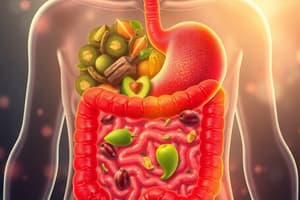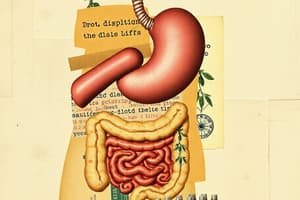Podcast
Questions and Answers
What is primarily absorbed in the small intestine?
What is primarily absorbed in the small intestine?
- Nutrients (correct)
- Water
- Vitamins
- Fiber
The liver produces bile to aid in the digestion of carbohydrates.
The liver produces bile to aid in the digestion of carbohydrates.
False (B)
What connects the pharynx to the stomach?
What connects the pharynx to the stomach?
oesophagus
The __________ in the stomach helps to prevent backflow of food.
The __________ in the stomach helps to prevent backflow of food.
Match the following organs to their functions:
Match the following organs to their functions:
Which of the following is NOT a function of the stomach?
Which of the following is NOT a function of the stomach?
Villi increase the surface area of the small intestine for absorption.
Villi increase the surface area of the small intestine for absorption.
What role does hydrochloric acid play in the stomach?
What role does hydrochloric acid play in the stomach?
What is the main function of the liver in digestion?
What is the main function of the liver in digestion?
The large intestine is about 1.5 meters long.
The large intestine is about 1.5 meters long.
What is the main role of amylase?
What is the main role of amylase?
The _______ prevents backflow in the stomach.
The _______ prevents backflow in the stomach.
Match the type of teeth with their main function:
Match the type of teeth with their main function:
What is the function of bile in digestion?
What is the function of bile in digestion?
Omnivores possess only sharp teeth for their diet.
Omnivores possess only sharp teeth for their diet.
What are the three parts of the small intestine?
What are the three parts of the small intestine?
Saliva contains _______ that begins the digestive process.
Saliva contains _______ that begins the digestive process.
How many teeth does an adult human typically have?
How many teeth does an adult human typically have?
Flashcards
Digestion
Digestion
The process of breaking down food into smaller molecules that the body can absorb and use for energy and growth.
Alimentary Canal
Alimentary Canal
A long, muscular tube that starts at the mouth and ends at the anus. It's where food travels through during digestion.
Mechanical Digestion
Mechanical Digestion
The process of breaking down large food pieces into smaller pieces, like chewing.
Chemical Digestion
Chemical Digestion
Signup and view all the flashcards
Pyloric Sphincter
Pyloric Sphincter
Signup and view all the flashcards
Villi
Villi
Signup and view all the flashcards
Large Intestine
Large Intestine
Signup and view all the flashcards
Bile
Bile
Signup and view all the flashcards
Peristalsis
Peristalsis
Signup and view all the flashcards
Enzyme
Enzyme
Signup and view all the flashcards
Substrate
Substrate
Signup and view all the flashcards
Product
Product
Signup and view all the flashcards
Absorption
Absorption
Signup and view all the flashcards
Saliva
Saliva
Signup and view all the flashcards
Study Notes
Essential for Human Survival
- Human survival depends on proper nutrition
Digestive System Overview
- Changes food into usable substances by the body
- The alimentary canal is a tube from mouth to anus
- Organs/glands add juices along the canal
- Two types of digestion: mechanical (breaking down into smaller pieces) and chemical (breaking into absorbable substances)
Mouth
- Initiates digestion mechanically (chewing)
- Saliva contains enzymes (e.g., amylase for digesting starch)
Esophagus
- Carries chewed food from the pharynx to the stomach using muscular contractions
Stomach
- Holds, churns, and chemically digests food
- Inner lining has folds for expansion
- Contains gastric juices with hydrochloric acid which kills bacteria and activates pepsin (protein digesting enzyme)
- Pyloric sphincter controls food leaving the stomach.
Liver
- Produces bile for fat digestion
Gallbladder
- Stores and releases bile into the small intestine
Pancreas
- Produces pancreatic juices (with enzymes for digesting all food types/ carbohydrates, fats, and proteins) into the small intestine
Small Intestine
- About 7 meters long; divided into duodenum, jejunum, and ileum
- Site of chemical digestion and nutrient absorption into the blood
- Villi (tiny projections) increase the surface area for absorption
- Nutrients absorbed through villi walls: Fats into lymph system, sugars and amino acids into portal vein to the liver
Large Intestine
- About 1.5 meters long; Includes the caecum, colon, appendix, rectum, and anus
- Absorbs water from the undigested material
- Eliminates waste
Teeth
- Adult humans have 32 teeth (16 in each jaw)
- Four types of teeth: incisors, canines, premolars, and molars
- Herbivores have large incisors and molars for plants
- Carnivores have large canines for tearing meat
- Omnivores have all types of teeth for varied diets.
Studying That Suits You
Use AI to generate personalized quizzes and flashcards to suit your learning preferences.




